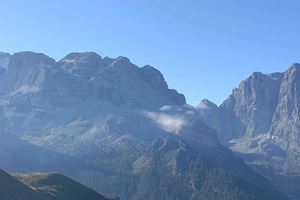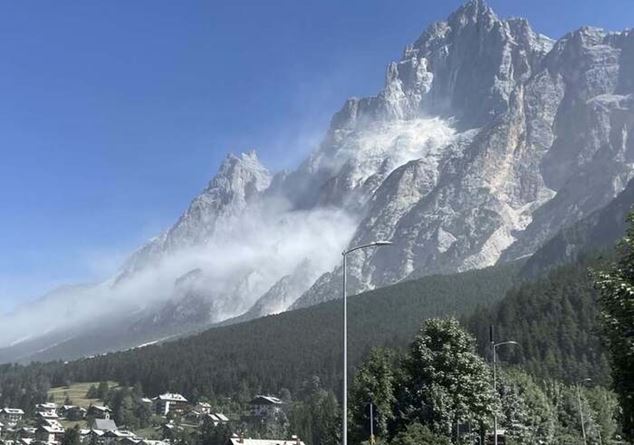They are increasingly frequent images: streams transformed into mud rivers, walls that crumble in the sun, landslides. The Dolomites – UNESCO World Heritage Site – in this summer 2025 prove more fragile than ever. The data of the geologists, the alpine rescue and the Italian Alpine Club say it: the landslides are increasing and, with them, the risks for hikers and mountaineers, also along itineraries considered “classic”.
According to the Summer Bulletin 2025 of the Central Scientific Committee of the CAIpublished in late June, “the effects of climatic warming on the mountain environment are intensifying”: we speak of accelerated fusion of the permafrost, early dissolution of the snow and worsening of the stability of the slopes. The document underlines that “many collapses and landslides are attributable to thermal rise and dry/rain alternation, which changes the balance of the rocky masses”.
The mountain moves
In the months of June and July, dozens of landslides were recorded in the eastern Dolomites: among the most recent, Two large collapses that took place between 27 and 28 July on Cima Falknerin the crystal group, and on the north side of the Mount Pelmoin Veneto. In both cases, very popular paths were closed due to the risk of further detachments.
In mid -June, a landslide detached himself from Croda Marcorain the Sorapiss group, overwhelming the roadway of the Statale 51 of Alemagna: for hours the area remained isolated. Here too, the authorities indicated as the main cause the combined action of sudden rains and instability due to the degradation of the Permafrost. The CAI spring 2025 bulletinreleased in April, had already foreseen “a complex summer on the level of the geological seal of the slopes”, reporting the Dolomite sectors over 2,000 meters as the most at risk.

Climate and instability: the voice of the experts
The CAI, through its scientific representatives, has launched the alarm for months. Piero Carlesipresident of the Central Scientific Committee of the Italian Alpine Club, on the occasion of the national day “Safe in the mountains of summer” on June 15, he said: “The increase in temperatures is compromising the stability of the glaciers and rocky bodies at high altitudemaking landslides and other increasingly frequent dangers ». A risk that concerns not only the large Dolomite walls, but also the medium and low hiking paths, subject to erosion, sagging and instability due to increasingly violent thunderstorms.
Elio Guastallinational coordinator for the prevention of CAI and Alpine Rescue, he added on the same occasion: «The right balance between passion and prudence is necessary to avoid ending up in uncontrollable risk situations. The unpreparedness, combined with the underestimation of the effects of the climate, exposes many people with avoidable dangers ».
A particularly useful recommendation today, in one of the hottest summer of the last decades. Also at altitudes above 1,500 meters, the temperatures exceed 30 ° C and violent afternoon thunderstorms error the slopesdig the paths and cause sudden landslides.
The recommendations for those who go to the mountains
The Alpine and speleological rescue of Trentino He has reiterated several times, even in recent local press releases, the need to change approach: “The mountain is not a playground”, reads. More attention, training and constant updating of information are needed before each excursion. Even the best known paths can prove insidious.
Here are some basic rules, also reported in the campaign Safe in the mountains 2025:
- Always check the weather bulletinseven the day of the excursion.
- Check the traveling of the paths through APT, refuges or local CAI sections.
- Avoid Canaloni and Beds of Torrente after recent rains or thunderstorms.
- Leave early in the morningto conclude the lap before the heat and bad weather.
- Bring adequate equipment (maps, GPS, technical clothing, sticks).
- Do not overrun your skills: Many accidents take place by imprudence.
A new awareness
The mountain is still the ideal place to find silence and beauty, but today requires a change of gaze. The CAI speaks more and more often than Mountain education as an integral part of attending it. “Safety is not just a matter of technique – said Guastalli at the event – but of culture, respect for the environment and its signals. We need a more responsible and less superficial attitude».
Also for this reason, the local sections of the CAI organize courses, guided exits and public meetings to update the population on the new risks of attending the high altitude.
Those who climb the mountains in recent months must know that it is no longer just a matter of weather or equipment: a profound transformation of the environment is at stake. The mountain “speaks” in a new way, and listening to it is the first step to really live it.
Photo © ANSA


